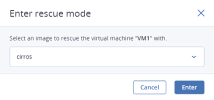Rescuing virtual machines
If a VM experiences boot problems, you can send it to the rescue mode to access its boot volume. When a VM in the “Active” state is sent to the rescue mode, it is shut down softly first. Once the VM is in the rescue mode, you can connect to it via SSH or via the console. Its previous boot disk is now attached as a secondary one. You can mount the disk and repair it.
Limitations
- This feature is available via GUI only for Linux virtual machines. It is also available via the command line for Windows VMs, as described in "Managing virtual machines" in the Administrator Command Line Guide.
- The rescue mode can only use qcow2 images (templates) for booting a VM. For instructions on making templates, refer to Preparing templates.
- You can send a VM to the rescue mode only if its current status is “Active” or “Shut down”.
- There are only three actions available for the VM in the rescue mode: Console, Exit rescue mode, and Delete.
- If a rescue image has cloud-init installed, then the VM booted from it can be accessed with the same SSH key that was used for its creation.
Prerequisites
- Virtual machines are created, as described in Creating virtual machines.
To put a virtual machine to the rescue mode
- On the Compute > Virtual machines > Virtual machines tab, click the required VM on the list.
- On the VM right pane, click the ellipsis button on the toolbar. Then, click Enter rescue mode.
-
In the Enter rescue mode window, select an image to rescue the VM with. By default, the initial image used for creating the VM is selected. Click Enter.
The machine status changes to “Rescue”.
To return a virtual machine to normal operation
- On the Compute > Virtual machines > Virtual machines tab, click the required VM on the list.
- On the VM right pane, click Exit rescue mode.
- In the Exit rescue mode window, click Exit. The VM will be automatically rebooted.
The VM status changes to “Active” and it boots from the original root disk.
If the VM status changes to “Error” when exiting the rescue mode, you can reset its status with the Reset state action. The VM should then return to the “Rescue” status again.
